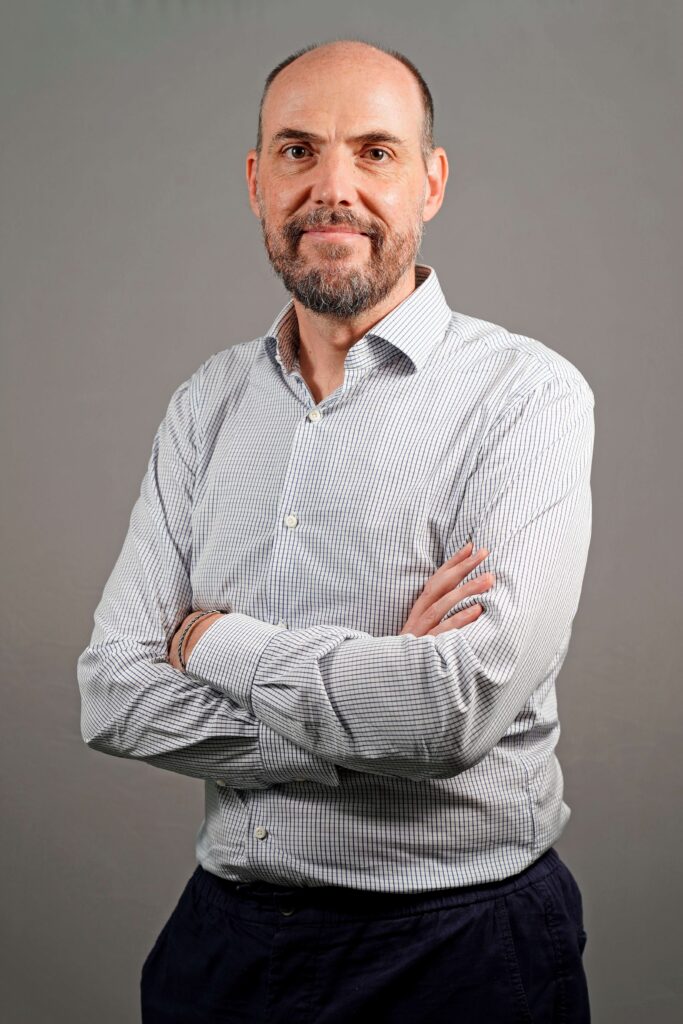“In IFMIF-DONES we must be prepared to work continuously outside the comfort zone”
Posted on |
 Santiago Becerril (Barcelona, 1975) is an Industrial Engineer from the Polytechnic University of Catalonia specialising in Machine Mechanics. During his career at IFMIF-DONES, since March 2021, he has accumulated responsibility in various aspects of the project. Among the most important is the coordination of the Test Systems Area, one of the largest that will make up the plant. This area includes all the modules that will be irradiated during operation, the shielded cavity that will house them, and infrastructures dedicated to other experimental uses. Becerril is also involved in several cross-cutting working groups dealing with specific technical aspects of the plant.
Santiago Becerril (Barcelona, 1975) is an Industrial Engineer from the Polytechnic University of Catalonia specialising in Machine Mechanics. During his career at IFMIF-DONES, since March 2021, he has accumulated responsibility in various aspects of the project. Among the most important is the coordination of the Test Systems Area, one of the largest that will make up the plant. This area includes all the modules that will be irradiated during operation, the shielded cavity that will house them, and infrastructures dedicated to other experimental uses. Becerril is also involved in several cross-cutting working groups dealing with specific technical aspects of the plant.
QUESTION (Q). Before joining the IFMIF-DONES team, you worked at the Instituto de Astrofísica de Andalucía. Did you always want to work among the stars?
ANSWER (A). It was always clear to me that I wanted to work in the field of instrumentation for scientific research in general. Then, my experience was channelled into specific scientific fields, among them those related to the stars, including my career at IFMIF-DONES in some way. As is well known, we are on the European roadmap for fusion, which aims to reproduce the particle dynamics inside stars to produce clean and highly available energy to some extent.
Q. IFMIF-DONES will be a unique machine in its configuration; how do you face the challenge of being responsible for the design of the test systems?
A. Firstly, we have a lot of motivation because of the significant challenges ahead of us and because of being involved in developing such a unique installation as IFMIF-DONES from the beginning. Secondly, we need a lot of flexibility because in these early stages of project development, there are many different needs to be covered, and we have to be fully prepared to continuously work outside our comfort zone, taking on activities that we may not be familiar with in the pursuit of the project.
In the Test Systems area, for example, some of the challenges are, on the one hand, to ensure almost 24/24 and 7/7 availability, with the very demanding and unique working conditions to which the irradiation modules in the shielded cavity, which will be the heart of the plant, will be subjected.
On the other hand, a whole family of detectors is needed to monitor the conditions inside the cavity that have never been subjected to conditions like those of IFMIF-DONES, and that requires a lot of research to have a reliable characterisation in this respect.
Finally, it is worth mentioning that the vacuum vessel in the cavity where the irradiation will take place will measure like a three-storey building and will be specified so that its deformation under working conditions will be 1 millimetre or less. We have a technically challenging road ahead of us.
Q. As an industrial engineer, you are used to sitting at the same table with researchers and scientists. How would you define this coexistence?
A. It is very fruitful and essential for the advancement of science. We are condemned to understand each other, although sometimes there may be an inevitable divergence between these groups. Simply put, we could say that engineers bring scientists’ ideas down to earth, providing them with the necessary limitations and boundary conditions. In contrast, for their part, scientists push engineers to take state of the art further and further and make projects possible that seemed unfeasible before.
Q. What is the main challenge facing the start-up and monitoring of the particle accelerator in Escúzar (Granada)?
A. This question is multi-faceted and quite complex. Let’s consider the start-up of the project in general. The first significant challenge is to attract all the necessary talent and provide the project with a minimum critical mass of human resources, with profiles that are very difficult to find in some cases. This is already complicated, but achieving it in only two or three years increases its difficulty considerably. Ultimately, new teams and departments will have to be integrated, all without slowing down the pace of the project and without having to launch highly complex tenders to incorporate the “in-kind contribution” that the different countries will provide. Implementing a good definition and integration of human teams will be fundamental.
On the other hand, and also very important, there are all the technological challenges we will face and have already identified. We know that there is no neutron source with the characteristics and specifications of IFMIF-DONES. For example, the accelerator part will have to generate beams of intensity unmatched anywhere in the world, and the liquid lithium loop will be the largest in the world, with very high flux stability requirements.
Apart from the challenges I have mentioned about the Test Systems, other examples could be the robotic and remote handling systems that will be needed for plant maintenance, the duration of which will have to be as short as possible to maximise the operational availability of the plant.
Q. Does the explosive progress of fusion technologies in recent years make you optimistic about the viability of fusion energy? How soon do you think it will become a reality?
A. IFMIF-DONES is planned to be operational in 2034. It will take years to produce, from the data and results it generates, the materials and systems that will first be used by DEMO, which will be the prototype fusion reactor with high availability.
DEMO’s operating period will have to be extended for some time before the most efficient and cost-effective constructive solutions can be consolidated, an aspect in which private enterprise will also play an important role.
Therefore, it will not be until the 50s or 60s of this century that the first pilot fusion reactor with high standards of availability and specifications for supplying energy to a specific population will become a reality.
However, it is essential to note that fusion will be a new player in the mix of energy sources in the future and will complement other sources. However, it will take several decades to become a significant source, as there will logically have to be an extended technological process over time to make solutions and technologies cheaper.
Q. A cure for cancer is your scientific wish; what do you expect from the medical applications of IFMIF-DONES?
A. What you are talking about is already on the table of the various experimental uses, apart from fusion targets, proposed for IFMIF-DONES. There are proposals for irradiation modules to generate critical isotopes for cancer treatments. Preliminary calculations tell us that IFMIF-DONES could produce an annual amount of isotopes equivalent to what Andalusia’s hospitals need in a year. We are studying this proposal and several others to look at all the technical aspects that could affect its viability.
Q. What are you asking for in 2024?
A. Although I am not one to ask for much, I would say to enjoy a new year with health and energy, never better said, the energy that we also need to prepare ourselves for the amount of work and difficulties that we will have to face to make this enormous challenge a reality.

